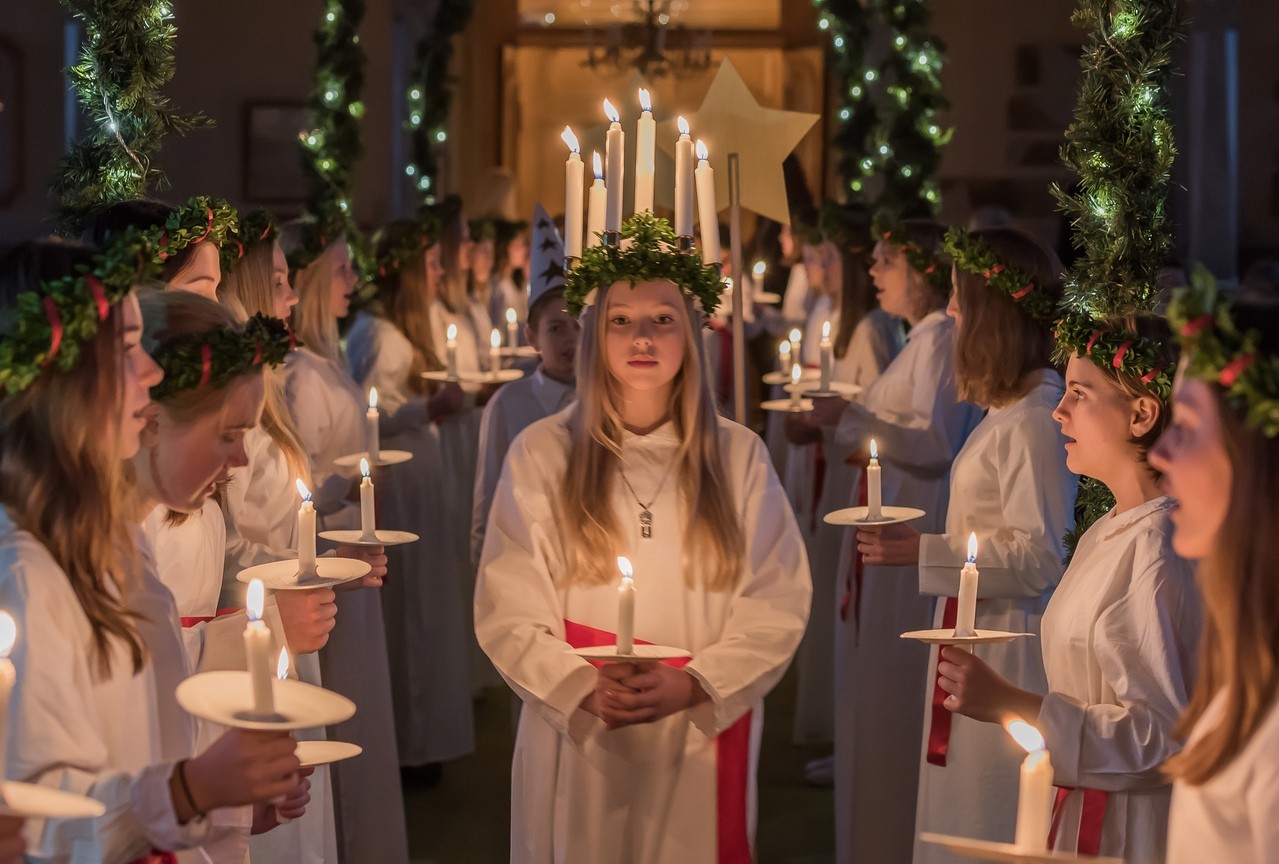圣露西亚节查看源代码讨论查看历史
 |
圣露西亚节[1] ,(Saint Lucy's Day),是基督宗教的圣人历中,纪念圣露西的节日。
简介
圣露西亚节(Saint Lucia's Day),是瑞典传统节日,设在每年的12月13日,又称瑞典露西亚日。
依据瑞典传统历法,12月13日被认为是一年中最长和最黑的夜晚。而12月13日过后,夜晚时间开始缩短,白昼时间渐渐增加,象征著光明,所以瑞典人以节日的方式庆祝这一天,并把这一天称为“迎光节”。
瑞典人十分重视圣露西亚节,每当12月一到,瑞典城乡大小商店便开始供应节日用品,其中销量最大的是蜡烛花冠和露西亚装。
圣露西亚节,是在将临期(耶稣圣诞前的准备期与等待期)中的12月13日,是斯堪的纳维亚会庆祝的节日。
瑞典地处高纬度的北欧地区,冬季漫长,白昼时间仅有几个小时。 瑞典北部位于北极圈内的基律纳地区,终日不见阳光。瑞典从11月起就渐渐被无边无际的黑暗与寒冷笼罩,戏剧《冰与火之歌》中人人朗朗上口的台词,在这里不只是一句逗趣的台词,而是准备迎接冬季的瑞典人口中一句十分写实,对现实充满无奈、绝望、与辛酸的招呼语。
好在12月13日的露西亚节(Luciadagen)给被黑暗笼罩的瑞典带来美丽的音乐,以及光明与希望,无论冬季的黑暗与寒冷多么漫长,传说中来自义大利西西里的圣女露西亚都会带领人们走出绝望。这个充满光明与希望的冬令节庆深受瑞典人喜爱。
历史传说
传说:(一)
露西亚是罗马帝国某官员的夫人,约出生在公元2世纪,热衷信奉基督教。
那时候,罗马当局对基督教十分仇视,派人刺瞎了露西亚的双眼,露西亚虽遭不幸,但仍虔诚地祈求著光明,不久终于出现了奇迹:露西亚睁开了双眼,重见了光明。
以后,心地善良美好的露西并被人们尊为圣女。
关于她的传说也一同随基督教传入瑞典,为了纪念露西亚,瑞典人民以她的名字举办节日。
传说:(二)
圣露西是第三世纪的基督徒烈士(Christian martyr),死于戴克里先迫害[2],依照基督教的传统,她 “带食物给藏在地下墓穴的基督徒,并且帮助他们,她头上戴著上面有蜡烛的花圈,让手空出来,可以多拿一些食物”[3][4]。
传说:(三)
有人认为露西亚的名字来自西元4世纪一个义大利西西里的女殉道者,相传她在生前帮助穷苦的囚犯,被认为是光明与希望的象征,也有一说认为露西亚这个名称可能跟基督教的恶魔路西法(Lucifer)有关。
圣露西亚节曾经和冬至重叠,也就是一年之中白天最短的一天,所以圣露西亚节也成为基督教光明的节日[5][6]。
在将临期的开始,圣露西亚节表示了圣诞节期(Christmastid)的开始,也就是预告了圣诞节基督之光的到来[2][7]。
外部连结
- Nordisk Familjebok, article Lucia Nordisk Familjebok, 1912 Template:Sv icon
- "A Nocturnal upon Saint Lucy's Day," poem by John Donne (1572–1631)
注解
- Eriksson, Stig A. (2002). Christmas traditions and performance rituals: a look at Christmas celebrations in a Nordic context. 2002. Applied Theater Researcher. No. 3. 6/3
- Nygaard, J. (1992). Teatrets historie i Europa ("~ History in Europe"). Volume 1. Oslo: Spillerom.
- NRK radio (2002). Språkteigen. NRK radio. December 2002.
参考资料
- ↑ 圣露西亚节,百科知识中文网
- ↑ 2.0 2.1 Hynes, Mary Ellen; Mazar, Peter. Companion to the Calendar. Liturgy Training Publications. 1993: 186 [12 December 2015]. ISBN 978-156854011-5.
Lucy's name means light. Coming midway through Advent, her feast day guides our hope towards the coming of Christ our Light. Lucy was a young woman of Syracuse in Sicily (an island off the southern coast of Italy). We know she died a martyr during the persecutions by the Roman emperor Diocletian.
- ↑ Barnhill, Carla. St. Lucy’s Day. Christian History Magazine.
- ↑ Hanson, Joelle. Santa Lucia Day traditions. ELCA. 13 December 2012 [12 December 2015]. (原始内容存档于2015-12-22).
Lucia means "light" and Santa Lucia became associated with light. In northern Europe, particularly Scandinavia, Spain and the Canary Islands, and her day fell on the shortest day of the year and was celebrated as they turned from the long winter nights and began to look forward to longer days. During the Roman persecutions, Lucia is said to have carried food to the poor in dark tunnels, wearing a wreath of candles on her head.
- ↑ St. Lucy. St. Lucy's Church, Scranton, Pennsylvania. [13 December 2014]. (原始内容存档于2015-03-06).
- ↑ Crump, William D. The Christmas Encyclopedia 3rd. Jefferson, NC: McFarland & Company. 2006. ISBN 978-0-7864-2293-7.
Prior to the adoption of the Gregorian calendar in the sixteenth century, St. Lucy's Day fell on the winter solstice, which poses a factor in her association with light, and her day Christianized a day formerly associated with the pagan Germanic goddess Berchta ...
- ↑ Hanson, Joelle. Santa Lucia Day traditions. ELCA. 13 December 2012 [12 December 2015]. (原始内容存档于2015-12-22).
The tradition of planting wheat on St. Lucy's Day comes from Hungary, Croatia and other European nations. Plant wheat grains in a round dish or plate of soil, then water the seeds. Place the container in a warm spot. If the planting medium is kept moist (not sopping wet), the seeds will germinate and the shoots will be several inches high by Christmas. Then the new green shoots, reminding us of the new life born in Bethlehem, may be tied with a ribbon, if desired, and a candle may be placed near them as a symbol of the Light of Christ.